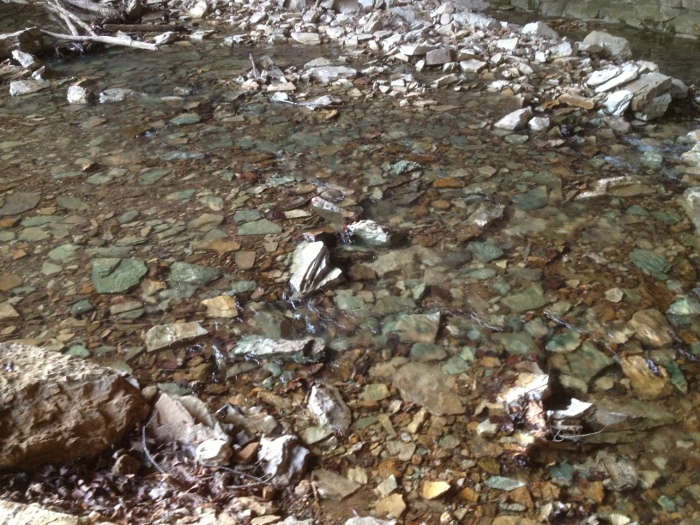(Unfortunately, these precautions have not prevented white nose syndrome from being spread to Carter Caves. I'm afraid its spread is unstoppable. Attempts to stop it might still slow it down enough that bat populations could acquire immunity and avoid catastrophic crashes, though.)
That left a short stroll from the Welcome Center to a large natural bridge as my remaining option. I've seen this many times, too, but because this is not a tour I can pause to appreciate the view. I'm only getting used to having both an iPhone and a blog, with the implication that I should take pictures and post them, but I did chance to remember this time.
The foot path goes underneath the natural bridge. Note that this is a very different kind of bridge than the one in Florida. In that case, a surface river enters a cave for 100 meters or so before exiting on the other side, where it resumes as a surface river. This example in Kentucky must have started out that way, but most of the cave has collapsed; also, to the untrained eye (that means me), it looks like the flow of this stream must have been much larger, at least episodically, in the past. At any rate, here we have a surface stream passing though a mostly dry tunnel.
Here is another view of the little stream that runs underneath the natural bridge. The stream may look tiny, but it flows at a good pace, and the many little waterfalls like the one you see in the foreground create a musical sound.
There are some nice colors in the rocks that make up the stream bed.
This is the other side of the tunnel. The tunnel is actually quite short: the two holes at the center left of this picture are also visible at the center left of the first picture.
Here is the path leading back to the Welcome Center. Look, I realize that some people will think that this stream is little more than they can see in a nearby ditch, and that these flakes of limestone are no more romantic than flakes of concrete. I only have a few responses. (1) This limestone is very old -- old enough that, unlike the limestone of Florida, it contains no fossil shells. To me there is something inherently interesting about rocks that were buried hundreds of millions of years ago that are only now being exposed by erosion. If you can't wonder at either the beauty of the scene or at the age of the rocks, you're simply built differently than I am. (2) This terrain is completely different than what I grew up with in Florida. As a result, it will probably always have a slightly magical feel to it. The same is true of snow. I certainly get tired of the cold and wet, and I hate the bad driving conditions it can create, but part of me is still ten years old and thinks that snow is something rare and wonderful. (3) What have you got against ditches? I remember having a lot of fun playing in ditches as a child, especially when I would build a dam across the ditch but leave a tiny gap that the water would go racing through. If I rarely notice the beauty of water running through a ditch any more, it's not because the beauty is not there, but because I have become too calloused to notice.
This picture gives a bit more context to the landscape in which the stream and natural bridge are found. The Welcome Center is visible in the upper right-hand corner. The stream continues for another 2 or 3 hundred yards before passing through another cave, this one fully flooded. Several dozen feet above is the X-cave, though which the stream ran thousands of years ago before erosion lowered the valley floor.
Between the spot where I took this picture and where I took the previous picture, I saw several bats out hunting insects. To the best of my memory, this is the first time I have seen a bat outside a cave clearly enough to be sure it was a bat. These were feeding just at and above the level of the tree tops -- just close enough that I could make out the characteristic inverted triangle shape of a bat against the sky, as well as their jagged flap-but-can't-glide flight paths. I think I've seen bats out and about in a few other places, but they were always so distant I could not be sure they weren't small birds. So even though white nose syndrome has made it to Carter Caves, at least some bats are still hanging on.






No comments:
Post a Comment